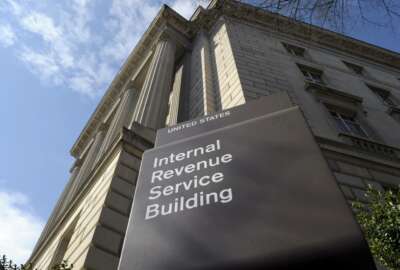IRS procurement shop develops web app to predict contract spending
The IRS obligates $2.5 billion a year in contract spending but one of the most common yet important questions in the contracting process is really hard to answer.
Best listening experience is on Chrome, Firefox or Safari. Subscribe to Federal Drive’s daily audio interviews on Apple Podcasts or PodcastOne.
The IRS, among other things, obligates $2.5 billion a year in contract spending. Strangely, one of the most common yet important questions in the contracting process is really hard to answer: When will a contract actually be signed by a contracting officer? Now the IRS procurement shop has developed a web app that produces a prediction. For how they did it and why it matters, Federal Drive with Tom Temin turned to the Director of Analytics Research and Technology in the Chief Procurement Office, Alicia Miller.
Interview transcript:
Tom Temin: Ms. Miller, good to have you on.
Alicia Miller: Great, it’s nice to be here.
Tom Temin: So we’ve heard about procurement lead time, the PALT question, and there’s lots of questions about the vagaries of procurement. But signing a contract, why is that difficult to know when, well, first of all, why is that?
Alicia Miller: Sure. There’s a long process that goes into making contracts happen. And at the end of the day, it really does require us to get that contract signed before we can get critical work to start. But because of the process and the length of time it takes to actually execute this, there does leave that question of when will you be able to start work? So the process that we underwent to model and develop this application was largely oriented around how can we better help customers plan work? How can we even better help our staff understand when those final contract documents are going to be signed to allow for that business planning?
Tom Temin: Well, if I have a program, and I need a contract to help fulfill it, I go to the contracting shop, because only a contracting officer can actually execute a contract on behalf of the government. Why can’t I as the program manager just pick up the phone and say, hey Alicia when are you going to sign that?
Alicia Miller: We do get that as well. So historically, this is exactly how it happened is there would be a phone call and say, hey when is this gonna happen? And then our contracting officer might just pick out a date and say, maybe sometime around March. But there’s different things that have to happen in the process. And so what we wanted to do is say, this is a gut instinct, can we use data to more consistently be able to say, based on what factors, this is when it’s going to happen. Can we make this more accessible so that you’re not just calling our contracting officer, especially in their busiest time of year, at the end of the year, when they are working through a lot of things? Can we provide a way for our customers to go in and self service to get some of this information?
Tom Temin: And what are some of the data elements that go into this then?
Alicia Miller: Sure. So we were able to pull data out of our internal contracting writing system, as well as the federal procurement data, but you can go in and you can look at a lot of different factors. So we can look at, for instance, the dollar value. When we look at the dollar value, there’s different levels of review and signatures that go into things. So there’s more process handling time that might happen. We also look at workload, if you have a lot on your plate, then it’s going to take longer to handle that then it does something shorter. So looking at a variety of these kind of factors, we were able to see how much these influence the potential signing date.
Tom Temin: So is the implication behind this, that there are steps leading to the point when a contract is assignable. And those are what you’re really looking at, not whether it’s ready to be signed, and the contracting officer decides, well, I’ll just do that one on Wednesday. Once it’s ready, they’ll sign it, right?
Alicia Miller: Absolutely. There’s different steps in the process, but also certain other factors that might influence these outcomes.
Tom Temin: As I imagine, this information is also important to contractors as well, right? They know they’re going to get a contract, presumably, they have won the bid, or they’ve won the task order – and so they probably want to know when they can start work too, they’ve got a lot of planning to do.
Alicia Miller: Absolutely. Now, our web app right now that we’ve developed, it’s being made operational inside the IRS. So it is going to be something that we can use internally, it will not be accessible to external vendors to get this information.
Tom Temin
Got it. We’re speaking with Alicia Miller, she’s director of analytics research and technology in the Chief Procurement Office at the IRS. If a vendor were to call and say, what does the crystal ball that you have say about the contract? You can tell them? That’s okay?Alicia Miller: Well, we can tell them the prediction. Obviously, with any data, there’s going to be a range. And so right now we have looking at the data nearly 90% predictive accuracy for within 30 days. So this is not going to say, here’s going to be the exact date, there’s going to be a range, but we can give you this ballpark.
Tom Temin: And what about delays and appropriations, which is pretty much routine now for Congress in the government, does that play into when something can be signed? Because that does obligate funds, and you can’t really do that without an appropriation it gets into the whole legal and anti deficiency business. Is that part of the equation here?
Alicia Miller: That’s not one of the factors that we include in the model, but that is certainly a consideration. For our purposes, we’d expect a lot of the contract request would come in with appropriate funding, so it would come in after we do have our side budget, the money is available and then we move forward with the process.
Tom Temin: And you are the director of analytics research and technology. What are some of the other types of things you tend to work on?
Alicia Miller: So we have a really fantastic team that focuses on the data systems inside looking at analytics, as well as helping with tools. So this is one of the examples of tools that we’re using. But we’ve also been able to implement and test various different automation processes that are helping us to make sure that we can look at are we implementing all of the right clauses that needed to be in contracts. Are we uploading information to our right folder management processes? And so being able to look at not just the analytic side, but also looking at how can we improve our processes. We’re looking at that full spectrum.
Tom Temin: Yes, cause contract writing systems are where these clauses get inserted, right? And I guess there’s growing realization that you don’t need every clause in every contract, because it’s confusing, both to the agency and to the contractors. And I guess I’m asking, is there some kind of automated way to determine which contracts need to drop in which need to be left out?
Alicia Miller: And that’s absolutely the type of stuff that we’re working on.
Tom Temin: Alicia Miller is director of analytics research and technology in the Chief Procurement Office at the IRS. Thanks so much for joining me.
Alicia Miller: You’re very welcome. You all have a great day.
Copyright © 2025 Federal News Network. All rights reserved. This website is not intended for users located within the European Economic Area.
Tom Temin is host of the Federal Drive and has been providing insight on federal technology and management issues for more than 30 years.
Follow @tteminWFED






